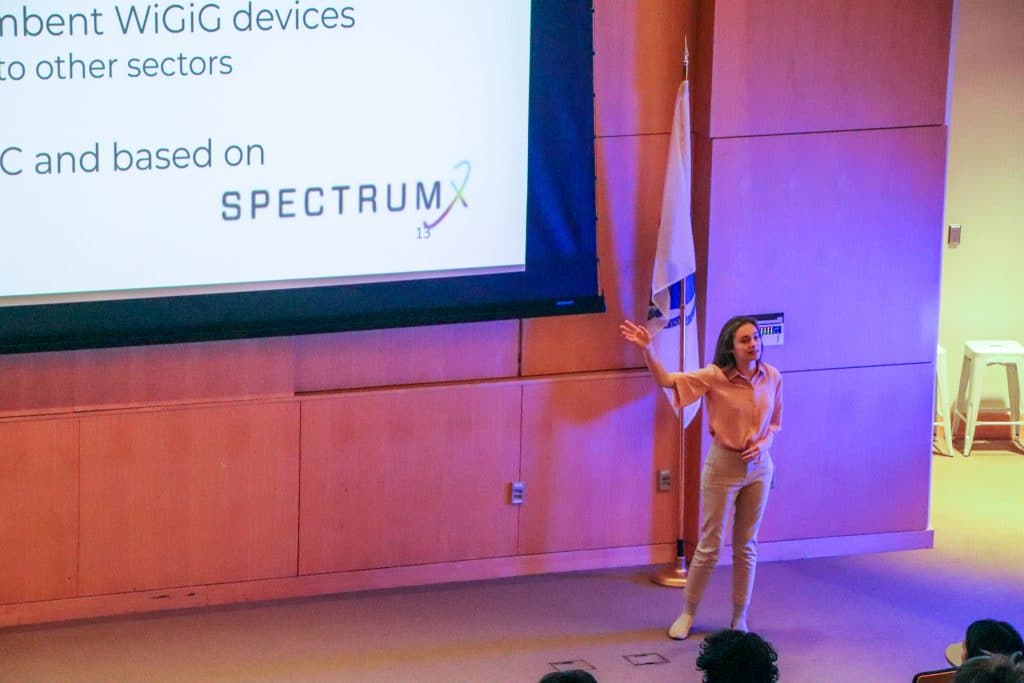January 13, 2023
By Christina Clark
It seemed like a normal group meeting for students to share updates. Olin College of Engineering undergraduate students filtered into an open lab on a chilly Monday evening in Needham, Massachusetts. A large antenna laid on its side, mid-build in one corner of the room, a cube satellite (cubesat) in another, and stacks of amateur radio guides are along a wall for learners to borrow and prepare for the licensing test. Around 20 group members gathered around a table, briefing the room and their advisor, Professor Whitney Lohmeyer, on their latest updates.
The students are a part of Lohmeyer’s Olin Satellite + Spectrum Technology & Policy (OSSTP) Group. Several are also members of her Introduction to Analog and Digital Communication class. In the group meeting, students in that course gave their final updates to Lohmeyer and prepared for the following day, Tuesday, December 6, when they gave final presentations on several radio spectrum coexistence challenges. The students’ final presentations were recorded, and will be utilized by SpectrumX, the National Science Foundation (NSF) Spectrum Innovation Center, to help introduce newcomers to the field of spectrum innovation.
Throughout the semester, the students researched their topics as small teams of two or three. Then, in October, the students presented interim findings to the attendees of the SpectrumX semi-annual center meeting, hosted at the University of Virginia. During the center meeting, the students received feedback from experts, researchers, and stakeholders, who they continued to engage with throughout the term.

“The students met with individuals who have dedicated their lives to some of these applications, developing hardware, launching satellites in the bands,” said Lohmeyer. “Since then, they have experienced the research process, made formal presentations, and have also walked away with contacts with whom they can continue to engage and hopefully form long-term career relationships.”
Research at this level is typically performed by graduate students. However, Lohmeyer is committed to providing undergraduate students at Olin College, which only offers undergraduate studies, with hands-on research experience. Building relationships in the field during undergraduate studies helps to include students in work that makes a lasting impact for others entering the field.
In addition to her faculty role at Olin, Lohmeyer is also the lead for the Use Cases and Coexistence Research Working Group for SpectrumX, and a research affiliate at MIT in Aeronautics and Astronautics.Through her courses, her lab (OSSTP Group), and the Olin Collegiate Amateur Radio Club (OCARC), she engages undergraduate students in research and studies that allow them to work with industry professionals outside of the campus. Lohmeyer hopes they will leave her course with a better understanding and intuition of communications theory, and a feel for whether pursuing research or graduate studies makes sense for them.
Update: More information and the presentation videos may be found at SpectrumX’s Undergraduate Education page.
Top image: Alex Butler, student at Olin College of Engineering, at the podium in Norden Auditorium, presenting a final project to the class, Professor Whitney Lohmeyer, and SpectrumX Center Director Nick Laneman.
About SpectrumX
SpectrumX is funded by the National Science Foundation (NSF) as part of its Spectrum Innovation Initiative, under grant number AST 21-32700. SpectrumX is the world’s largest academic hub where all radio spectrum stakeholders can innovate, collaborate, and contribute to maximizing social welfare of this precious resource.
To learn more about SpectrumX, please visit spectrumx.org.
Contact:
Christina Clark, Research Communications Specialist
SpectrumX / Notre Dame Research / University of Notre Dame
cclark26@nd.edu / 574.631.2665
spectrumx.org

